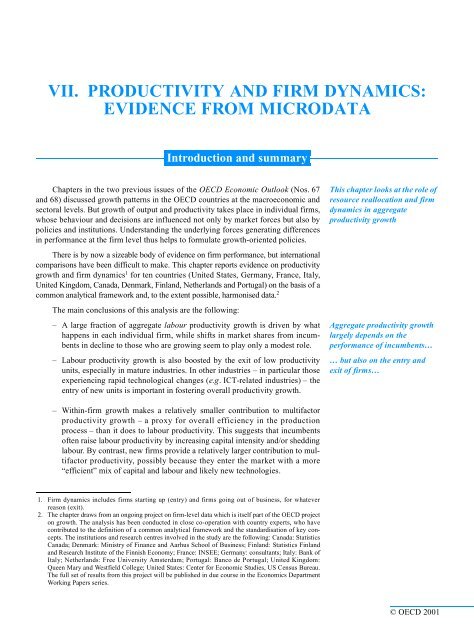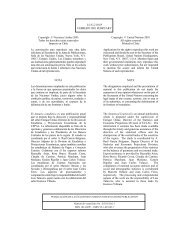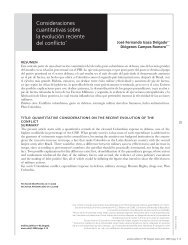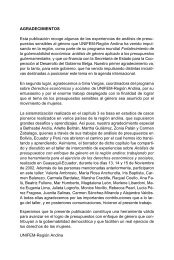OECD Economic Outlook 69 - Biblioteca Hegoa
OECD Economic Outlook 69 - Biblioteca Hegoa
OECD Economic Outlook 69 - Biblioteca Hegoa
Create successful ePaper yourself
Turn your PDF publications into a flip-book with our unique Google optimized e-Paper software.
VII. PRODUCTIVITY AND FIRM DYNAMICS:<br />
EVIDENCE FROM MICRODATA<br />
Introduction and summary<br />
Chapters in the two previous issues of the <strong>OECD</strong> <strong>Economic</strong> <strong>Outlook</strong> (Nos. 67<br />
and 68) discussed growth patterns in the <strong>OECD</strong> countries at the macroeconomic and<br />
sectoral levels. But growth of output and productivity takes place in individual firms,<br />
whose behaviour and decisions are influenced not only by market forces but also by<br />
policies and institutions. Understanding the underlying forces generating differences<br />
in performance at the firm level thus helps to formulate growth-oriented policies.<br />
There is by now a sizeable body of evidence on firm performance, but international<br />
comparisons have been difficult to make. This chapter reports evidence on productivity<br />
growth and firm dynamics 1 for ten countries (United States, Germany, France, Italy,<br />
United Kingdom, Canada, Denmark, Finland, Netherlands and Portugal) on the basis of a<br />
common analytical framework and, to the extent possible, harmonised data. 2<br />
The main conclusions of this analysis are the following:<br />
– A large fraction of aggregate labour productivity growth is driven by what<br />
happens in each individual firm, while shifts in market shares from incumbents<br />
in decline to those who are growing seem to play only a modest role.<br />
– Labour productivity growth is also boosted by the exit of low productivity<br />
units, especially in mature industries. In other industries – in particular those<br />
experiencing rapid technological changes (e.g. ICT-related industries) – the<br />
entry of new units is important in fostering overall productivity growth.<br />
– Within-firm growth makes a relatively smaller contribution to multifactor<br />
productivity growth – a proxy for overall efficiency in the production<br />
process – than it does to labour productivity. This suggests that incumbents<br />
often raise labour productivity by increasing capital intensity and/or shedding<br />
labour. By contrast, new firms provide a relatively larger contribution to multifactor<br />
productivity, possibly because they enter the market with a more<br />
“efficient” mix of capital and labour and likely new technologies.<br />
1. Firm dynamics includes firms starting up (entry) and firms going out of business, for whatever<br />
reason (exit).<br />
2. The chapter draws from an ongoing project on firm-level data which is itself part of the <strong>OECD</strong> project<br />
on growth. The analysis has been conducted in close co-operation with country experts, who have<br />
contributed to the definition of a common analytical framework and the standardisation of key concepts.<br />
The institutions and research centres involved in the study are the following: Canada: Statistics<br />
Canada; Denmark: Ministry of Finance and Aarhus School of Business; Finland: Statistics Finland<br />
and Research Institute of the Finnish Economy; France: INSEE; Germany: consultants; Italy: Bank of<br />
Italy; Netherlands: Free University Amsterdam; Portugal: Banco de Portugal; United Kingdom:<br />
Queen Mary and Westfield College; United States: Center for <strong>Economic</strong> Studies, US Census Bureau.<br />
The full set of results from this project will be published in due course in the <strong>Economic</strong>s Department<br />
Working Papers series.<br />
This chapter looks at the role of<br />
resource reallocation and firm<br />
dynamics in aggregate<br />
productivity growth<br />
Aggregate productivity growth<br />
largely depends on the<br />
performance of incumbents…<br />
… but also on the entry and<br />
exit of firms…<br />
© <strong>OECD</strong> 2001
















